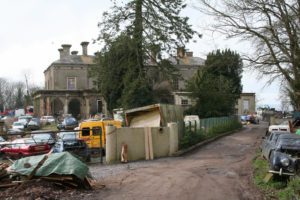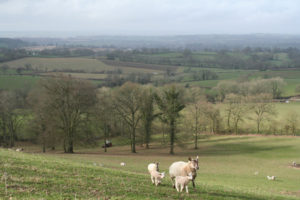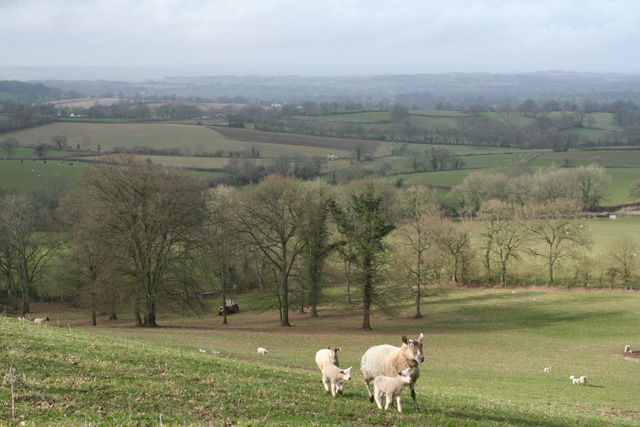08 February 2018
Country Living
A valid choice in spite of certain ‘deprivations’.
By Lynda Goetz
 Not all, but many of those who live in the country have made a conscious decision to do so. It may well mean that they do not have world-class theatre on the doorstep; that public transport is either minimal or non-existent; that a meal in a restaurant or a visit to a museum or gallery requires some forward planning; but, clearly, there are compensations. Property is available to buy at less than a squillion pounds a square foot; the air is breathable and not full of vehicle emissions, as traffic is generally infrequent; exercise in the form of walking, riding, cycling (or in some places sky-diving, kite-surfing, wind-surfing etc) is easily accessible. In spite of the patronising views of many urbanites, they do not necessarily hanker after some of the ‘delights’ of modern living such as on tap spas, cocktail bars or conference centres (although most would like better broadband!). Employment opportunities are more limited, but an hour’s drive is surely no worse than the congested commute that many Londoners have to put up with on crowded trains and jam-packed tubes?
Not all, but many of those who live in the country have made a conscious decision to do so. It may well mean that they do not have world-class theatre on the doorstep; that public transport is either minimal or non-existent; that a meal in a restaurant or a visit to a museum or gallery requires some forward planning; but, clearly, there are compensations. Property is available to buy at less than a squillion pounds a square foot; the air is breathable and not full of vehicle emissions, as traffic is generally infrequent; exercise in the form of walking, riding, cycling (or in some places sky-diving, kite-surfing, wind-surfing etc) is easily accessible. In spite of the patronising views of many urbanites, they do not necessarily hanker after some of the ‘delights’ of modern living such as on tap spas, cocktail bars or conference centres (although most would like better broadband!). Employment opportunities are more limited, but an hour’s drive is surely no worse than the congested commute that many Londoners have to put up with on crowded trains and jam-packed tubes?
Clearly these aspects of life are little understood by the West London developer who in 2015 bought the Grade II listed Blackborough House in the Area of Outstanding Natural Beauty (AONB) that is the Blackdown Hills. He has promised to restore the house to its former glory -by turning it into a 60 bedroom hotel and running it as a ‘multi-use events venue’ which will ‘cater for weddings, corporate events and exhibitions’, to use the wording on the website (Blackborough House). This, according to a press release, will ‘promote both short term and long term local employment and produce revenue through tourism and trade which will, in turn, ensure the long term future of the building’. The 40 households which make up the village of Blackborough do not wish to be portrayed as NIMBYS and most would be delighted to see Blackborough House brought back from the brink of decay, but not at the cost of the life they and those in surrounding villages have chosen.
Blackborough is a close-knit community. The resident who claims to have lived there longest has apparently been there for 36 years. This in West Country terms is not long at all, so most have chosen to move there. Blackborough’s 40 households include 50 school-age children, most of whom attend the primary school down the hill in Kentisbeare or the secondary school in nearby Uffculme. As there are no pavements, the children use the road to walk, cycle or ride between each other’s homes. Cycling down to friends in Kentisbeare however is probably out as the return journey up the hill has, although jokingly, quite accurately been described as ‘an extreme sport’. This is a long serious hill (1 in 4). The road is single track with sharp bends and few passing places. It has nevertheless been designated by the developer in his application as one of the three potential (indeed only) routes for access to his hotel (presumably also for the necessary construction traffic over the next few years if the application is approved).
 Blackborough House was built between 1838 and 1840 by the fourth and last Earl of Egremont, George Francis Wyndham. It has been semi-derelict or derelict for the last 60 odd years. Although it was listed in 1987, no attempts at ensuring any stabilisation of the crumbling building were taken either by the owner or the council. It was for much of that time used (first illegally and then with a CLU, a Certificate of Lawful Use) as a car breakers yard. Although latterly there was very little activity and the previous owner’s licence to operate as a scrap yard was revoked, from a planning point of view that apparently makes no difference. In applying for development, the new owner can now cite national statistics for the volume of traffic generated by a scrapyard of that size and use this to support his own application. In other words, if the amount of traffic generated by a 60-bed hotel and conference centre does not significantly exceed the amount estimated to be generated by use as a scrapyard, then that will act in his favour. (And of course he could effectively threaten to turn it back into a breakers yard)
Blackborough House was built between 1838 and 1840 by the fourth and last Earl of Egremont, George Francis Wyndham. It has been semi-derelict or derelict for the last 60 odd years. Although it was listed in 1987, no attempts at ensuring any stabilisation of the crumbling building were taken either by the owner or the council. It was for much of that time used (first illegally and then with a CLU, a Certificate of Lawful Use) as a car breakers yard. Although latterly there was very little activity and the previous owner’s licence to operate as a scrap yard was revoked, from a planning point of view that apparently makes no difference. In applying for development, the new owner can now cite national statistics for the volume of traffic generated by a scrapyard of that size and use this to support his own application. In other words, if the amount of traffic generated by a 60-bed hotel and conference centre does not significantly exceed the amount estimated to be generated by use as a scrapyard, then that will act in his favour. (And of course he could effectively threaten to turn it back into a breakers yard)
At the moment, all this is up for grabs, as is the application to build seven marble-clad villas, which even the planning officer has suggested are not ‘quite in keeping’ with their surroundings under Historic England’s (formerly English Heritage) ‘Enabling Development’. This, basically, is development which would not normally be permitted, but where profits would enable heritage repairs to be carried out. Given the strict interpretation of planning laws which has hitherto been applied in places like Blackborough, residents are, quite understandably, concerned at current developments. They would be very happy with ‘sustainable’ development and see this as possible with a much smaller-scale undertaking or preferably a residential development (turning the house into apartments as has been done with other large properties in the county) which would see new residents able to join their community and enjoy the lifestyle. Transient tourists and business people forming part of a large-scale endeavour, far exceeding the size of the community onto which it has been grafted, does not seem to those affected to be the way forward.
At this stage it is hard to know how things will move forward. At a well-attended local meeting on Tuesday evening, the highways officer expressed himself ready to receive anecdotal evidence about the volume of traffic generated by the scrapyard over the last 30 or so years. The planning officer stated that the application was categorised as a ‘major’ development and as such the time limit for the decision-making process would be at least 13 weeks and could be double that. He also kept reiterating that all the evidence needed to be looked at and reviewed in the light of ‘policies’ not emotion. This clearly is the way it works, and if ‘shouty’ minorities are not to have their way this has to be right. Councillors or planning officers may not refuse a planning proposal simply because many people oppose it.
Most of those forming the community of Blackborough already have work and are highly unlikely to take up what will effectively be low-paid work in the hospitality industry. This is not viewed by most as a welcome development. It will massively increase traffic in the area, leading to road safety concerns. It will impact lifestyles in the village and surrounding areas as well as raising concerns about wildlife in an AONB with protected species. There will be unavoidable noise and light pollution. Most importantly for all those who have chosen to live there is that they will be swamped by a development they consider totally unsuitable for the site and location. Residents had hoped that the massive sale of all the rusting relics surrounding the crumbling mansion back in September 2016 might herald the beginning of a better era.
 Nothing stands still, everything changes, but change should not lead to uniformity. Blackborough is a small rural hamlet which as someone pointed out at the meeting doesn’t “even have a shop. We certainly don’t need a spa.” Those who live there have chosen a way of life which is not city life. Planning policies should be able to respect that choice. Uniformity is not the way forward. Many of those who have opted for ‘country living’ (as opposed to Country Living) with its inconveniences have already lived urban life and no longer wish to do so. They still love visiting and know this also works the other way round; but the scale has to be proportionate. A 60-bed hotel and ‘multi-events venue’ on the edge of a 40-household hamlet with narrow and difficult access is not proportionate.
Nothing stands still, everything changes, but change should not lead to uniformity. Blackborough is a small rural hamlet which as someone pointed out at the meeting doesn’t “even have a shop. We certainly don’t need a spa.” Those who live there have chosen a way of life which is not city life. Planning policies should be able to respect that choice. Uniformity is not the way forward. Many of those who have opted for ‘country living’ (as opposed to Country Living) with its inconveniences have already lived urban life and no longer wish to do so. They still love visiting and know this also works the other way round; but the scale has to be proportionate. A 60-bed hotel and ‘multi-events venue’ on the edge of a 40-household hamlet with narrow and difficult access is not proportionate.


